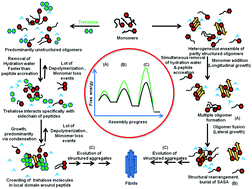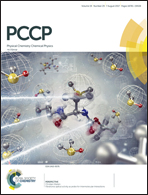Inhibition of GNNQQNY prion peptide aggregation by trehalose: a mechanistic view†
Abstract
Deposition of amyloid fibrils is the seminal event in the pathogenesis of numerous neurodegenerative diseases. The formation of this amyloid assembly is the manifestation of a cascade of structural transitions including toxic oligomer formation in the early stages of aggregation. Thus a viable therapeutic strategy involves the use of small molecular ligands to interfere with this assembly. In this perspective, we have explored the kinetics of aggregate formation of the fibril forming GNNQQNY peptide fragment from the yeast prion protein SUP35 using multiple all atom MD simulations with explicit solvent and provided mechanistic insights into the way trehalose, an experimentally known aggregation inhibitor, modulates the aggregation pathway. The results suggest that the assimilation process is impeded by different barriers at smaller and larger oligomeric sizes: the initial one being easily surpassed at higher temperatures and peptide concentrations. The kinetic profile demonstrates that trehalose delays the aggregation process by increasing both these activation barriers, specifically the latter one. It increases the sampling of small-sized aggregates that lack the beta sheet conformation. Analysis reveals that the barrier in the growth of larger stable oligomers causes the formation of multiple stable small oligomers which then fuse together bimolecularly. The PCA of 26 properties was carried out to deconvolute the events within the temporary lag phases, which suggested dynamism in lags involving an increase in interchain contacts and burial of SASA. The predominant growth route is monomer addition, which changes to condensation on account of a large number of depolymerisation events in the presence of trehalose. The favourable interaction of trehalose specifically with the sidechain of the peptide promotes crowding of trehalose molecules in its vicinity – the combination of both these factors imparts the observed behaviour. Furthermore, increasing trehalose concentration leads to faster expulsion of water molecules than interpeptide interactions. These expelled water molecules have larger translational movement, suggesting an entropy factor to favor the assembly process. Different conformations observed under this condition suggest the role of water molecules in guiding the morphology of the aggregates as well. A similar scenario exists on increasing peptide concentration.



 Please wait while we load your content...
Please wait while we load your content...